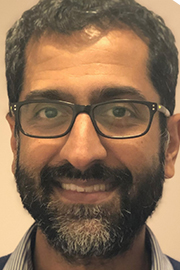 By Keynote ContributorDr. Prakash Ramachandran MRC Senior Clinical Fellow & Consultant Hepatologist
By Keynote ContributorDr. Prakash Ramachandran MRC Senior Clinical Fellow & Consultant Hepatologist Written by Keynote Contributor, MRC Senior Clinical Fellow and Consultant Hepatologist Dr. Prakash Ramachandran of the University of Edinburgh.
The burden of liver disease and challenges in developing effective liver disease treatments
Liver disease is a huge global health problem, affecting an estimated 1.5 billion people and resulting in over two million deaths yearly. That rate is rising, driven by alcohol-related liver disease and the huge increase in non-alcoholic fatty liver disease (NAFLD) associated with obesity and diabetes.
Regardless of the cause, chronic damage to the liver results in scar tissue, or fibrosis, forming, which often leads to, and speeds up, complications such as liver failure or liver cancer.
Because scarring is such an important factor in liver disease progression, much effort is now being focused on developing new treatments to try and reduce the amount of fibrosis in the liver. Many drugs have been tested in patients, but no treatments have succeeded.
This is partly due to the complexity and duration of the disease, with different factors regulating fibrosis over many years or even decades. Historically, the field has also been very reliant on models of disease to understand the biology, which often don’t replicate the complexity of human physiology.
In recent years, huge advances in biomedical technologies and data analysis approaches available to clinicians and researchers are making it possible to study patient samples at unprecedented depth and resolution, providing new insights into liver disease pathophysiology. These data types will form the basis for a new tranche of treatment targets over the forthcoming years.
Scotland's unique position for liver disease research
In Scotland, we currently have a confluence of factors – data capacity, clinical and academic expertise, and technology – that put us in pole position to translate our excellent liver disease research and to develop the innovative new treatments we need.
Firstly, we have unprecedented access to human samples where, often, researchers only have access to animal samples. We have permissions as part of a study I am leading called Liver Cell Analysis (LiCA) to take a piece of a patient’s liver biopsy and extra blood samples and use them to build up a high-resolution profile of changes in cells, genes, and proteins in different types of liver disease and at different stages of disease progression. We can also link these changes to clinical metadata. And we also have access to archived biopsy samples and their related clinical metadata.
This access to clinical metadata is extremely important. Unlike health systems elsewhere, the Scottish National Health Service is a single provider, so it keeps data from all its health boards – biopsies and outcomes. This means we can nail down which pathways in the liver are associated with different clinical outcomes in a way others cannot.
Scotland is also spearheading ethical health data sharing, with initiatives such as DataLoch and the Data-Driven Innovation hubs through the southeast region City Deal and the SteatoSITE data commons. With colleagues such as Professor Jonathan Fallowfield we have used the latter, for example, to identify groups of genes in the liver which can predict the progression of NAFLD and the future development of liver disease complications.

Image Credit: mi_viri/Shutterstock.com
The third factor is our profiling capability. At the University of Edinburgh, we have significant expertise in technologies such as single-cell or single-nucleus RNA sequencing to study liver scarring in high definition. Our previous research in patients with advanced fibrosis discovered sub-types of three key cells: white blood cells called macrophages, endothelial cells – which line blood vessels – and scar-forming cells known as myofibroblasts. Now, we can study these, and other cells, across the full disease spectrum.
We also have access to the world’s best spatial technologies. Using the Akoya PhenoCycler-fusion system and soon the Nanostring CosMx spatial molecular imager, we can study hundreds of markers on a single liver sample. Applying these methods to our patient biopsy samples will transform our understanding of liver fibrosis over the next few years.
We have an established network of research-supportive hepatologists in Scotland who contribute to clinical research. Discovery studies can be rapidly scaled and conducted in multiple centers. Edinburgh’s Bioquarter, designed to bring together clinicians, researchers, and patients in one place, is one such center.
We also have a strong track record in related spinouts, such as Resolution Therapeutics, developing macrophage cell therapies; Stimuliver, using pluripotent stem cells, or SensiBile’s biomedical device that can assess the quality of donor's livers. Our Edinburgh academics are ably supported by our commercialization service, Edinburgh Innovations, which strengthens our capacity to work with industry and translate research into real-world solutions.
Lastly, and this is nothing positive, Scotland has a high disease burden. Sadly, we have one of the highest rates of liver disease in Europe, with a rising incidence, which, although not a selling point for our country, does increase the impetus for the prevention and treatment of liver disease and fibrosis.
The road to transforming liver disease treatment
In cancer treatment, advances are being made through the use of ‘-omics’ technologies – measuring large numbers of genes or proteins to inform a more stratified approach to disease. For liver disease, too, we hope to be able to use genes and proteins found in patients’ liver or blood to identify which patients need treatment and which treatment options are likely to work best for them to reduce fibrosis and prevent them from developing complications.
The challenge remains the heterogeneity and duration of the disease, as different patients may require several combinations of treatments, and it can often take years for a beneficial effect to be identified, necessitating clinical trials incorporating huge numbers over a long time.
Scotland has the regulatory framework, collaboration with the National Health Service, robust research infrastructure, funding support, and collaborative networks to conduct such trials.
There is much work to be done, but I believe here, in the footsteps of medical pioneers Fleming and and Lister, we are uniquely placed to transform liver disease and fibrosis treatment and improve patient outcomes on a global scale.
References
- Ramachandran P, Dobie R, Wilson-Kanamori JR, Dora EF, Henderson BEP et al. Resolving the fibrotic niche of human liver cirrhosis using single-cell transcriptomics. Nature. 575, 512–518 (2019).
- Fallowfield JA, Kendall TJ, Jimenez-Ramos M, Turner F, Ramachandran P et al. SteatoSITE: an Integrated Gene-to-Outcome Data Commons for Precision Medicine Research in NAFLD, 18 April 2023, PREPRINT (Version 1) available at Research Square [https://doi.org/10.21203/rs.3.rs-2805134/v1]
- Cheemerla, S. and Balakrishnan, M. (2021) "Global Epidemiology of Chronic Liver Disease", Clinical Liver Disease, 17(5), pp. 365-370. doi: 10.1002/cld.1061.
- Devarbhavi, H. et al. (2023) "Global burden of Liver Disease: 2023 Update", Journal of Hepatology. doi: 10.1016/j.jhep.2023.03.017.
- Scotland, P. (2023) Liver disease mortality – Liver disease mortality – Publications – Public Health Scotland, Publichealthscotland.scot. Available at: https://publichealthscotland.scot/publications/liver-disease-mortality/liver-disease-mortality/#section-1 (Accessed: 5 June 2023).
About Dr. Prakash Ramachandran
Dr Prakash Ramachandran is an MRC Senior Clinical Fellow at the University of Edinburgh Centre for Inflammation Research and an Honorary Consultant Hepatologist at the Royal Infirmary of Edinburgh. He undertook medical training at the University of Edinburgh, graduating in 2003. He subsequently completed a Wellcome Trust funded PhD (2008-2011), an MRC Clinician Scientist Fellowship (2016-2020) and was recently awarded an MRC Senior Clinical Fellowship (2022-2027) entitled “Therapeutic Targeting of Pathogenic Scar-associated Macrophages in the Fibrotic Niche of Chronic Liver Disease”. His group’s research is focussed on using single-cell and spatial -omics approaches to study the role of the immune system in regulating liver injury and fibrosis. Specifically, his work has defined the heterogeneity of hepatic macrophages in chronic liver disease, identifying key populations with orchestrate fibrosis and fibrosis regression.
His group’s research is focussed on using single-cell and spatial -omics approaches to study the role of the immune system in regulating liver injury and fibrosis. Specifically, his work has defined the heterogeneity of hepatic macrophages in chronic liver disease, identifying key populations with orchestrate fibrosis and fibrosis regression.
Disclaimer: This article has not been subjected to peer review and is presented as the personal views of a qualified expert in the subject in accordance with the general terms and conditions of use of the News-Medical.Net website.
Last Updated: Jun 5, 2023
Source: Read Full Article
